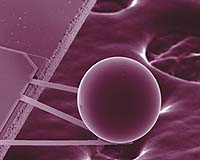 |
Seattle WA (SPX) Feb 03, 2010 Phase transitions - changes of matter from one state to another without altering its chemical makeup - are an important part of life in our three-dimensional world. Water falls to the ground as snow, melts to a liquid and eventually vaporizes back to the clouds to begin the cycle anew. Now a team of scientists has devised a new way to explore how such phase transitions function in less than three dimensions and at the level of just a few atoms. They hope the technique will be useful to test aspects of what until now has been purely theoretical physics, and they hope it also might have practical applications for sensing conditions at very tiny scales, such as in a cell membrane. They worked with single-walled carbon nanotubes, extremely thin, hollow graphite structures that can be so tiny that they are nearly one-dimensional, to study the phase transition behavior of argon and krypton atoms. "The physics can be quite different in fewer than three dimensions," said David Cobden, an associate professor of physics at the University of Washington and corresponding author of a paper describing the work published Friday (Jan. 29) in Science. Co-authors, all from the UW, are Zenghui Wang, Jiang Wei, Peter Morse, J. Gregory Dash and Oscar Vilches. For their observations, the group used carbon nanotubes, microscopic cylinders that have some thickness but are very close to being one-dimensional. Phase transitions change the density of atoms. In the vapor form, there are fewer atoms and they are loosely packed. Liquid has more atoms and they are more tightly packed. The solid is a crystal formed of very tightly packed atoms. To determine the phase of the argon and krypton atoms, the researchers used the carbon nanotube much like a guitar string stretched over a fret. A nearby piece of conducting metal applied an electrical force to oscillate the string, and the scientists measured the current to "listen" as the vibration frequency changed - a greater mass of atoms sticking to the nanotube surface produced a lower frequency. "You listen to this nano guitar and as the pitch goes down you know there are more atoms sticking to the surface," Cobden said. "In principle you can hear one atom landing on the tube - it's that sensitive." The researchers also found that the nanotube's electrical resistance changed when krypton atoms stuck to the surface. In the future, the scientists hope to be able to see how the atoms, as they populate the carbon nanotube, react to each other through various phase transitions, and also how they interact with the pure carbon graphite of the nanotube. They expect to see some significant differences in experiments approaching one dimension from those in two or three dimensions. "For example, matter can freeze in 3-D and in 2-D, but theoretically it should not freeze in 1-D," Cobden said. Besides providing a test bed for physics theories, the work also could be useful for sensing applications, such as nanoscale measurements in various fluid environments, examining functions within cell membranes or probing within nerves. "Nanotubes allow you to probe things at the subcellular level," Cobden said.
Share This Article With Planet Earth
Related Links University of Washington Nano Technology News From SpaceMart.com Computer Chip Architecture, Technology and Manufacture
 Science seeks to control the Casimir force
Science seeks to control the Casimir forceArgonne, Ill. (UPI) Dec 10, 2009 U.S. scientists say they are seeking a way of controlling the Casimir force -- a quantum mechanical force that hampers creation of nanoscale machines. Researchers at the Department of Energy's Argonne National Laboratory said the Casimir force, which attracts objects when they are only 100 nanometers apart, is so small most experimentation has only dealt with its characteristics. ... read more |
|
| The content herein, unless otherwise known to be public domain, are Copyright 1995-2010 - SpaceDaily. AFP and UPI Wire Stories are copyright Agence France-Presse and United Press International. ESA Portal Reports are copyright European Space Agency. All NASA sourced material is public domain. Additional copyrights may apply in whole or part to other bona fide parties. Advertising does not imply endorsement,agreement or approval of any opinions, statements or information provided by SpaceDaily on any Web page published or hosted by SpaceDaily. Privacy Statement |